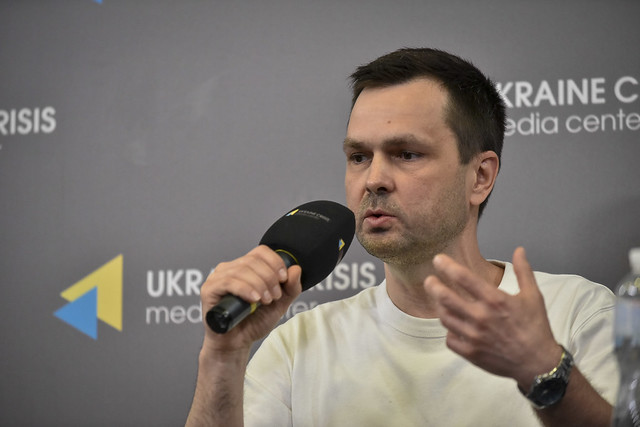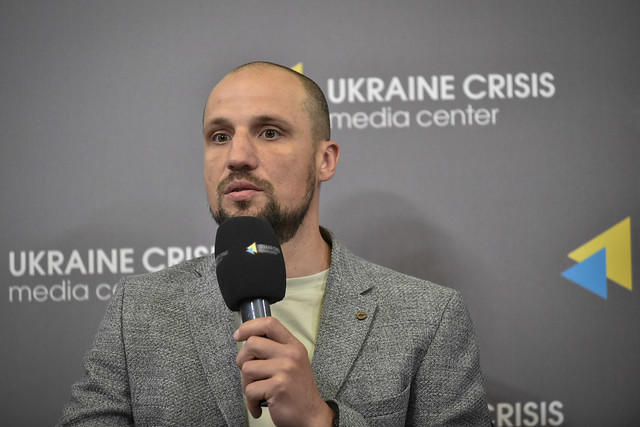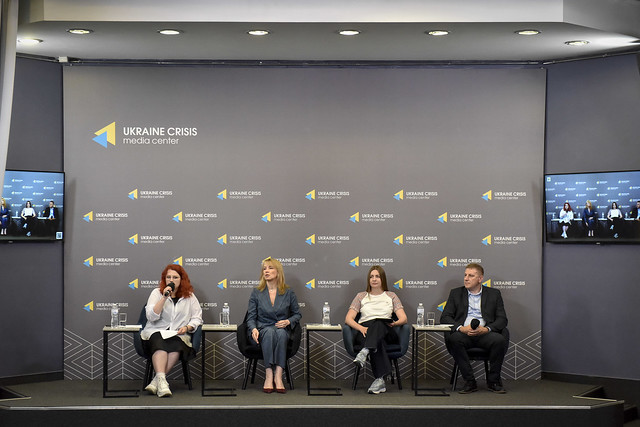On 20 June, the Cherkasy Human Rights Centre, with the support of the International Renaissance Foundation, held a presentation and discussion on ‘Provision of Housing for Internally Displaced Persons in Ukraine’. Experts discussed the state of housing policy for IDPs and ways to solve systemic problems.
Since the beginning of Russia’s full-scale invasion, more than 4.6 million Ukrainians have become internally displaced. The majority of them still do not have permanent housing and are forced to live in compact settlements that often do not meet basic standards. More than 1.2-1.3 million Ukrainian families have lost their homes because of the war, including not only IDPs but also residents of destroyed cities and towns.
The World Bank estimates that at least $86 billion is needed to rebuild the destroyed and damaged housing stock in Ukraine. Through the Diia system, citizens have filed more than 850,000 applications for housing damage, covering more than 60 million square metres. For comparison, before the war, Ukraine annually commissioned only 9-10 million square metres of housing.
– ‘In three years of war, Russia has destroyed what we have been building for at least six years,’ said Olena Shulyak, chair of the Verkhovna Rada Committee on the Organisation of State Power and Local Self-Government.

According to a study by the Cherkasy Human Rights Centre, which covered 721 communities in Ukraine as of October 2024, the situation with housing for IDPs is critical. Dmytro Naumenko, a project expert, notes that out of more than 4.3 million people in need of housing, only 35 have received social housing from local communities.
– Only 35 premises were provided for internally displaced persons from all the communities that responded. We can understand how low this figure is and how much this figure does not cover the huge needs,” the expert noted.
“The reasons for this situation lie not only in the lack of funds. Social housing was in decline even before the war, and the war has further reduced the already scarce housing stock. In addition, many communities simply lack the institutional capacity to effectively manage housing programmes. The lack of strategic planning and coordination between different levels of government means that even available resources are not used effectively. This situation demonstrates a deep systemic failure to meet the basic social needs of citizens.
Failures at the local level
Taras Shcherbatiuk, head of the Cherkasy Human Rights Centre, spoke about his work with IDPs in five regions of Ukraine. Since 2014, more than 10,000 people have applied to human rights organisations, and most of the issues related to housing.

– We have seen how people are settled in places of compact settlement that do not meet decent living conditions at all. These are non-residential premises, which are prohibited by law,” said Taras Shcherbatiuk.
“The implementation of government resolutions No. 495 of 29 April 2022 and No. 930 of 1 September 2023, which provide for the procedure for creating temporary housing funds and the functioning of places for temporary residence of internally displaced persons, has failed. At the community level, there is no systematic work to create temporary housing funds for internally displaced persons, and places for temporary residence do not meet basic living conditions.
Many local authorities perceive IDPs as a temporary problem that should be resolved by itself after the war ends. This approach leads to people living in terrible conditions for years – in basements, unfinished buildings, and unsuitable premises. This creates additional social tensions in communities and undermines people’s trust in state institutions.
Dmytro Naumenko, a lawyer at the NGO MART, also drew attention to the problem of the lack of local regulations governing the procedure for putting people on the housing waiting list.
Half of the communities do not know what the housing stock is
Alina Moskalenko, Director of the Institute of Housing, presented the shocking results of the study – a critical gap between the needs of people and the ability of communities to respond to them.

– ‘Most communities in Ukraine could not answer a simple question: how much housing is in communal ownership in this community,’ the expert noted.
“Out of 710 communities with which the Housing Institute had constant communication, half of them had to be explained over the phone the basic concepts: what is communal property, housing stock, and how to account for it.
According to the study, half of the communities acknowledged the lack of technical knowledge and staff to implement housing projects. In 58% of local governments, one or two people deal with all housing issues. 84% of communities reported a lack of stable funding.
As a result, local communities were unprepared for the large-scale challenges posed by the war. Lack of basic knowledge of housing management means that even if funds are available, communities will not be able to use them effectively.
Modular townships: the temporary has become permanent
The problem of so-called crisis housing – modular towns that were supposed to be a short-term solution – is particularly painful. In practice, people live in them for years.
– ‘In Chernihiv Oblast, there are modular towns where people have been living for three years, although when they were settled there, ministers assured them that it would be a maximum of one year,’ says Dmytro Naumenko.
“The conditions in such towns are often unbearable – it is very difficult to live there in summer and winter. Some modular towns have not functioned for a single day because people refuse to live there.
The main problem with modular towns is their lack of adaptation to the Ukrainian climate. In summer, the temperature inside can reach 40 degrees, and in winter, heating systems cannot cope with frost. The lack of proper sound insulation makes living in such a settlement a constant stress.
The financial sustainability of such facilities has become a serious challenge. Modular towns become a financial burden for communities, as the entire burden of their maintenance falls on local budgets. Utilities, repairs, security – all of this costs significant funds that communities often do not have.
The problem is exacerbated by the psychological aspect – people do not perceive modular towns as a home, which creates additional social tensions. Lack of privacy, limited space, and the inability to create comfort affect the mental health of residents, especially children.
Unaffordability of housing
Even for those who have the means, buying their own home has become an unattainable dream. Alina Moskalenko (Director of the Institute of Housing) cited impressive figures: to buy an apartment in Kyiv, an average citizen has to save their entire salary for 11 years. In Dnipro – 7 years. At the same time, real estate prices did not decline during the war, but rather increased several times.
– In 2024, only 500 families were provided with housing under the 3% concessional mortgage lending programme. If we continue at this pace, it will take 1400 years to provide all Ukrainians with housing,” Alina Moskalenko calculated.
The ‘There is a Home’ programme has provided loans worth more than UAH 28 billion, but the largest share (52%) is for military personnel. IDPs have received only 566 loans.
The situation is further complicated by the fact that the war has caused real estate prices in relatively safe regions to rise rather than fall. Demand far exceeds supply, especially in the western regions of Ukraine, where people from the east and south have moved en masse.
The situation with the rental market is particularly critical. MP Vitaliy Voitsekhivskyi noted the failure of the government’s rental subsidy programme: ‘If several dozen contracts have been signed for the whole of Ukraine, it seems to me that this is a failed project.’ At the same time, 90-95% of IDPs rent unofficially, which makes them vulnerable to the arbitrariness of landlords.

Experts emphasise that the problem of unaffordable housing is systemic and requires not only financial solutions, but also a fundamental change in approaches to housing policy. Without the development of affordable rental housing and social programmes, millions of Ukrainians will be left without prospects for their own homes.
Legislative initiatives
Olena Shulyak, Chair of the Verkhovna Rada Committee on the Organisation of State Power, noted that the parliament is working on several key draft laws in the field of housing policy. The most important is the draft law No. 12377 ‘On the Basic Principles of Housing Policy’, which is to replace the outdated Housing Code of 1983.
– ‘We are destroying the outdated Soviet scheme and are committed to introducing new approaches to housing policy,’ explained Olena Shulyak.
However, MP Vitaliy Voitsekhivskyi acknowledged the delays, but identified the urgency of the need as the number one issue: ‘Unfortunately, we are behind schedule, but I hope that we will get to this draft law in the next plenary week.’
Among the plans until 2027:
- Allocation of €650 million for the eRecovery programme
- 450 million euros for IDPs, defenders of Ukraine and families of the fallen
- Creation of a social housing fund
- Introduction of a unified state analytical housing system
The problem is that the current Housing Code of 1983 simply does not contain such concepts as social rent or communal housing. The legislation is not keeping up with the realities of today, especially in wartime.
Experts emphasise the need not only to adopt a new law, but also to develop Ukraine’s first national housing strategy with the support of the World Bank and the European Commission. This strategy should define long-term goals and mechanisms for achieving them.
Law 4080 on housing inventory should become an important element of legislative changes. Taras Shcherbatiuk emphasised the need for a high-quality inventory:
– “There is a lot of housing in Ukraine that can be converted into separate apartments with little financial effort. Not modular towns, but separate housing.
He also called for the inclusion of representatives of civil society and international donors in the inventory commissions, as the public is currently not represented there, which can lead to abuse and inefficient use of resources.
In parallel with the work on the main law, bylaws are being developed to regulate specific mechanisms for housing provision, queuing, and criteria for selecting recipients of assistance. Without these documents, even the best laws will remain declarative.
Border regions: a challenge of particular complexity
Natalia Yesina, Head of the Northern Human Rights Group and Head of the IDP Council at the Sumy City Council, spoke about the situation in Sumy region, where more than 99,000 IDPs are registered.
– More than 70,000 are those who have moved within the region. ‘The border is hot, it is shelled every day, and people do not want to leave,’ the expert explained.
In Sumy region, there are 20 temporary settlement sites in 10 communities, but they are not filled very actively due to uncomfortable living conditions of 2-4 people in a room and the inability to keep pets.
– ‘A woman was just walking around for a day and was thinking about where to put her dog, because she couldn’t leave it in the compact settlement,’ Yesina said of a typical situation. Due to its proximity to the front line – the city of Sumy is 20 kilometres from the active combat zone – it is difficult to talk about long-term solutions. The region has already started active cooperation with other regions to coordinate the evacuation of people.
International support: potential and challenges
When analysing international programmes to support housing initiatives, experts found a critical lack of information.
– ‘When we started analysing the international programmes aimed at building or reconstructing destroyed housing, I must say that there is very little information in the information field,’ said Taras Shcherbatiuk, head of the Cherkasy Human Rights Centre.

Even official inquiries to the Cabinet of Ministers and ministries did not provide a comprehensive picture.
Among the identified programmes:
- The World Bank’s HOPE programme – $232 million with a potential expansion to $800 million
- IFC investment programmes – construction of temporary housing in Chernivtsi and Khotyn community
- Programmes of the European Investment Bank and German KfW – pilot projects in Lviv and Ivano-Frankivsk regions
- Programmes of international organisations – Red Cross, Danish Refugee Council, Caritas Ukraine, People in Need
Viktor Gladchenko from People in Need noted that humanitarian organisations can help 10-20% of the total needs, which is only a drop in the bucket. Гуманітарні організації працюють за простою схемою: отримують кошти від донорів, ремонтують або створюють житло і передають кінцевому споживачу. Але є проблема масштабування.
– We can help 100, 200, 300, 500 people if we unite everyone. What humanitarian organisations are doing in terms of the scale of damage is a very small percentage, 10-20 per cent,” stated Gladchenko.
Yuriy Putria, head of the NGO ‘Against Corruption’, spoke about the experience of Mykolaiv region, which is home to almost 122,000 IDPs, of which 70% are intra-regional IDPs from frontline communities.
A positive example was the work with the HOPE programme in Mykolaiv. The city team has developed 57 projects to restore multi-storey buildings damaged by shelling. The programme provides funds for design and estimate documentation and then raises funds for reconstruction.
– In 2026, almost 50% of this programme has already been funded for reconstruction,” the expert said.
Systemic problems
The main challenges for the housing sector in times of war are:
- Limited financial resources
- Extreme inequality in access to housing
- Lack of a unified state vision of housing policy
- Corruption and non-transparency in housing allocation
- Outdated legislation
- Weak institutional capacity of communities
Recommendations of the experts
Following the discussion, the experts put forward key recommendations:
- Increase transparency – authorities should be more open with information about international programmes and their results
- Scale up successful practices – use the positive experience of individual regions to spread throughout the country
- Develop partnerships – create effective cooperation between the state, international organisations and the public sector
- To train personnel – to teach local authorities to work according to European standards
- Conduct a qualitative housing inventory in accordance with Law 4080 with the involvement of civil society and international donors
- Systematic needs assessment – to determine how many people need housing, what is their economic profile, and what mechanisms they can use
The need for change
Experts emphasise the need to move from helping only the most vulnerable to an inclusive housing policy where everyone can exercise their right to housing. We need tenant support mechanisms, the development of social housing and a transparent financing system.
– Without a high-quality housing policy, we will not be able to give people a sense of security, restore their trust in the state and create a basis for sustainable post-war recovery,” summed up Alina Moskalenko.
“Solving the housing crisis requires coordinated action at the local, national and international levels. Time is against Ukraine – given the possible deterioration of the situation in the border regions, the country must be ready to provide housing for potentially millions of people. Otherwise, millions of Ukrainians risk being left without decent housing for years to come.


Source: Cherkasy Information Platform

